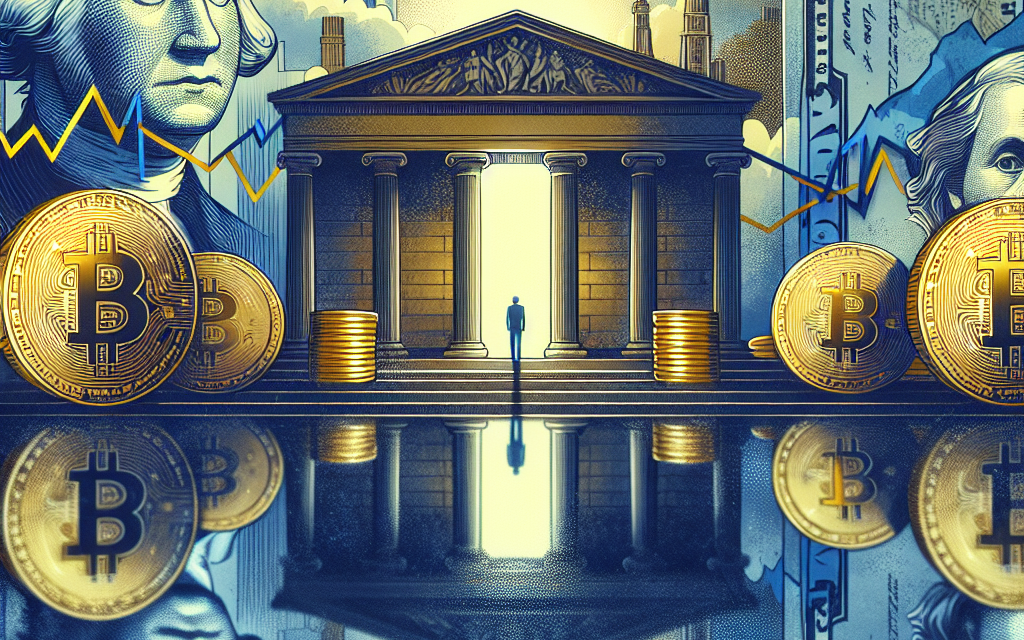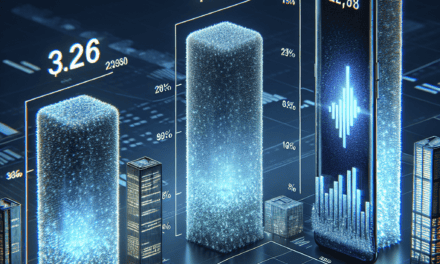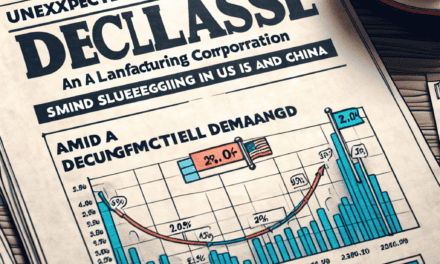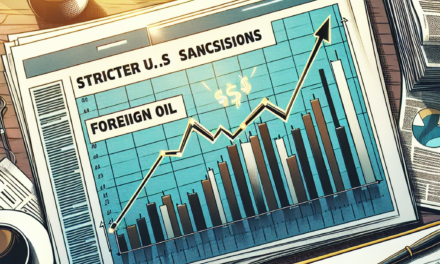“Navigating the Economic Waves: Reflation Concerns in Bidenomics”
Introduction
This Week in Bidenomics: Reflation Concerns Arise examines the emerging economic dynamics under the Biden administration as the U.S. economy navigates the complex landscape of post-pandemic recovery. With a focus on the potential for reflation—a scenario where inflation rises due to increased demand and economic activity—this analysis delves into the factors driving these concerns, including fiscal policies, consumer spending patterns, and global supply chain disruptions. As policymakers and economists debate the implications of reflation, this week’s insights provide a comprehensive overview of the challenges and opportunities facing the Biden administration in steering the economy towards sustainable growth while managing inflationary pressures.
Understanding Reflation: What It Means for the Economy
In recent discussions surrounding economic policy, the term “reflation” has emerged as a focal point, particularly in the context of the Biden administration’s economic strategies. Reflation refers to the process of stimulating the economy by increasing the money supply or reducing taxes, with the aim of bringing an economy back to its long-term growth trend following a period of deflation or economic stagnation. This concept is distinct from inflation, which involves a general increase in prices and a decrease in the purchasing value of money. Understanding reflation is crucial, as it can have significant implications for both the economy and individual financial well-being.
The Biden administration has implemented a series of fiscal policies designed to spur economic growth, especially in the wake of the COVID-19 pandemic. These measures include substantial government spending on infrastructure, social programs, and direct financial assistance to individuals and businesses. While these initiatives aim to boost economic activity and employment, they also raise concerns about potential reflationary pressures. As the economy recovers, the increased demand for goods and services could lead to higher prices, which, if not managed carefully, might transition into inflation.
Moreover, the Federal Reserve plays a pivotal role in managing reflationary dynamics. By adjusting interest rates and engaging in open market operations, the Fed can influence the money supply and, consequently, economic activity. In recent months, the Fed has maintained a relatively accommodative monetary policy stance, keeping interest rates low to support the recovery. However, this approach has sparked debate among economists and policymakers about the potential for overheating the economy, which could lead to sustained inflationary pressures.
Transitioning from theory to practice, the real-world implications of reflation are multifaceted. On one hand, reflation can be beneficial by reducing unemployment and increasing consumer spending, which are vital for a robust economic recovery. On the other hand, if not carefully monitored, reflation can lead to an overheated economy, where demand outpaces supply, resulting in persistent inflation. This delicate balance requires policymakers to remain vigilant and responsive to changing economic conditions.
Furthermore, the global context cannot be ignored when discussing reflation. The interconnectedness of modern economies means that reflationary policies in one country can have ripple effects worldwide. For instance, increased demand in the United States can lead to higher imports, affecting trade balances and potentially leading to currency fluctuations. Additionally, global supply chain disruptions, exacerbated by the pandemic, can amplify reflationary pressures by constraining the availability of goods and driving up prices.
In conclusion, while reflation is a critical component of the current economic landscape, it requires careful management to ensure that the benefits of economic recovery are not overshadowed by the risks of inflation. Policymakers must strike a balance between stimulating growth and maintaining price stability, a task that is as challenging as it is essential. As the Biden administration continues to navigate these complex dynamics, the coming weeks and months will be crucial in determining the trajectory of the U.S. economy. By understanding the nuances of reflation, stakeholders can better anticipate and respond to the challenges and opportunities that lie ahead.
Bidenomics and Inflation: A Closer Look at Current Trends
In recent weeks, the economic landscape has been dominated by discussions surrounding inflation, with particular attention on the phenomenon of reflation. As the Biden administration continues to implement its economic policies, concerns about rising prices and their potential impact on the economy have come to the forefront. Reflation, a term used to describe the process of stimulating the economy by increasing the money supply or reducing taxes, has become a focal point in the discourse on Bidenomics. This week, the conversation has intensified as new data and expert analyses shed light on the current trends and future implications of these economic strategies.
The Biden administration’s approach to economic recovery has been characterized by substantial fiscal stimulus measures, aimed at revitalizing an economy battered by the COVID-19 pandemic. These measures, including the American Rescue Plan and proposed infrastructure investments, have injected significant liquidity into the market. While these actions have been credited with spurring economic growth and reducing unemployment, they have also raised concerns about the potential for overheating the economy. As consumer demand surges, supply chain disruptions and labor shortages have contributed to upward pressure on prices, leading to heightened inflationary fears.
In this context, reflation concerns have emerged as a critical issue. Economists and policymakers are closely monitoring inflation indicators, such as the Consumer Price Index (CPI) and the Producer Price Index (PPI), to assess the trajectory of price increases. Recent reports have shown a notable rise in these indices, prompting debates about whether the current inflationary trends are transitory or indicative of a more persistent problem. The Federal Reserve, tasked with maintaining price stability, has reiterated its stance that the recent inflation spike is largely temporary, driven by pandemic-related factors that are expected to subside over time. However, some experts caution that prolonged inflation could necessitate a shift in monetary policy, potentially leading to interest rate hikes that could dampen economic growth.
As the debate over inflation continues, it is essential to consider the broader implications of reflationary policies. On one hand, these measures have played a crucial role in supporting economic recovery, particularly for lower-income households and small businesses that were disproportionately affected by the pandemic. By boosting consumer spending and investment, reflationary policies have contributed to a robust rebound in economic activity. On the other hand, the risk of sustained inflation poses challenges for both consumers and businesses, as rising costs can erode purchasing power and profit margins.
In navigating these complex dynamics, the Biden administration faces the delicate task of balancing economic growth with price stability. Policymakers must carefully calibrate their strategies to ensure that the benefits of reflation are not overshadowed by the adverse effects of inflation. This requires a nuanced understanding of the interplay between fiscal and monetary policies, as well as a willingness to adapt to evolving economic conditions.
As we move forward, the discourse on Bidenomics and inflation will undoubtedly continue to evolve. The coming weeks and months will be critical in determining the trajectory of the U.S. economy and the effectiveness of the administration’s economic policies. By closely monitoring inflation trends and remaining responsive to emerging challenges, policymakers can work towards fostering a sustainable and inclusive economic recovery. In this dynamic environment, the ability to anticipate and address reflation concerns will be paramount in shaping the future of the American economy.
The Impact of Reflation on Consumer Spending
This week in Bidenomics, the focus has shifted to the growing concerns surrounding reflation and its potential impact on consumer spending. As the economy continues to recover from the disruptions caused by the COVID-19 pandemic, policymakers and economists are closely monitoring the signs of reflation, which refers to the increase in prices and economic activity following a period of deflation or economic stagnation. While reflation can be a positive indicator of economic recovery, it also raises concerns about the potential for inflationary pressures that could affect consumer spending patterns.
To understand the implications of reflation on consumer spending, it is essential to first consider the factors contributing to this economic phenomenon. The Biden administration’s fiscal policies, including substantial stimulus packages and infrastructure investments, have injected significant liquidity into the economy. These measures, combined with the Federal Reserve’s accommodative monetary policy, have spurred economic growth and increased demand for goods and services. Consequently, businesses are experiencing higher input costs, which are often passed on to consumers in the form of higher prices.
As prices begin to rise, consumers may face a dilemma. On one hand, the increase in prices can lead to a sense of urgency to purchase goods before they become even more expensive, potentially boosting short-term consumer spending. On the other hand, sustained price increases can erode purchasing power, leading consumers to become more cautious with their spending. This cautiousness is particularly evident in households with fixed or lower incomes, who may find it challenging to keep up with rising costs.
Moreover, the psychological impact of reflation cannot be underestimated. As consumers witness price increases across various sectors, from groceries to housing, their expectations about future inflation may shift. This shift in expectations can influence consumer behavior, prompting individuals to alter their spending habits. For instance, consumers might prioritize essential goods and services over discretionary spending, thereby affecting sectors that rely heavily on consumer confidence and discretionary income.
In addition to altering spending patterns, reflation can also impact consumer sentiment. As prices rise, consumers may become more concerned about their financial well-being and the overall economic outlook. This concern can lead to a decrease in consumer confidence, which is a critical driver of economic activity. A decline in consumer confidence can result in reduced spending, further complicating the economic recovery process.
However, it is important to note that not all effects of reflation on consumer spending are negative. For some consumers, particularly those with investments in assets that benefit from rising prices, reflation can lead to increased wealth and spending capacity. Additionally, as businesses adjust to the new economic environment, they may increase wages to attract and retain workers, thereby boosting disposable income and supporting consumer spending.
In conclusion, while reflation is a sign of economic recovery, it presents a complex set of challenges and opportunities for consumer spending. Policymakers must carefully balance their efforts to sustain economic growth while mitigating the potential adverse effects of rising prices on consumers. As the situation evolves, it will be crucial to monitor consumer behavior and sentiment to ensure that the economic recovery remains on a stable and sustainable path. By understanding the multifaceted impact of reflation, stakeholders can better navigate the economic landscape and support a resilient consumer base.
How Reflation Concerns Are Shaping Economic Policy
This week in Bidenomics, the focus has shifted to the growing concerns surrounding reflation and its implications for economic policy. As the global economy continues to recover from the disruptions caused by the COVID-19 pandemic, policymakers are increasingly attentive to the potential for reflation, a scenario where inflation rises as economic growth accelerates. This phenomenon, while indicative of a recovering economy, poses significant challenges for economic policy, particularly in balancing growth with price stability.
Reflation concerns have emerged as a central theme in economic discussions, primarily due to the unprecedented fiscal and monetary measures implemented to combat the pandemic’s economic fallout. The Biden administration’s expansive fiscal policies, including substantial stimulus packages, have injected significant liquidity into the economy. While these measures have been instrumental in supporting households and businesses, they have also contributed to increased demand, which, coupled with supply chain disruptions, has exerted upward pressure on prices.
In response to these developments, the Federal Reserve has maintained a cautious stance, emphasizing its commitment to achieving maximum employment and price stability. However, the central bank faces a delicate balancing act. On one hand, it must support the ongoing economic recovery; on the other, it must prevent the economy from overheating, which could lead to sustained inflationary pressures. The Fed’s recent signals suggest a gradual approach to tapering its asset purchases, a move aimed at normalizing monetary policy without derailing the recovery.
Moreover, the interplay between fiscal and monetary policy is crucial in addressing reflation concerns. The Biden administration’s infrastructure and social spending plans, while aimed at fostering long-term economic growth, have sparked debates about their inflationary impact. Critics argue that such expansive fiscal measures could exacerbate inflationary pressures, necessitating a more aggressive monetary policy response. Conversely, proponents contend that these investments are essential for addressing structural issues and enhancing the economy’s productive capacity, thereby mitigating inflationary risks in the long run.
As policymakers navigate these complex dynamics, international factors also play a significant role in shaping reflation concerns. Global supply chain disruptions, driven by pandemic-related constraints and geopolitical tensions, have contributed to rising input costs and inflationary pressures. Additionally, energy prices have surged, further complicating the inflation outlook. These global factors underscore the interconnected nature of modern economies and the need for coordinated policy responses.
In light of these challenges, economic policy is increasingly focused on ensuring a sustainable recovery while managing inflationary risks. This involves not only adjusting monetary and fiscal policies but also addressing structural issues that could impede long-term growth. For instance, investments in infrastructure, education, and technology are seen as critical for enhancing productivity and competitiveness, thereby alleviating supply-side constraints and supporting stable growth.
In conclusion, reflation concerns are shaping economic policy in significant ways, prompting a reevaluation of the balance between growth and price stability. As the Biden administration and the Federal Reserve navigate this complex landscape, their policy decisions will have far-reaching implications for the economy’s trajectory. By carefully calibrating fiscal and monetary measures and addressing structural challenges, policymakers aim to foster a resilient and inclusive recovery that mitigates the risks of sustained inflation. As these efforts unfold, the interplay between domestic and global factors will continue to influence the economic outlook, underscoring the importance of adaptive and forward-looking policy frameworks.
Analyzing the Role of Fiscal Stimulus in Reflation
In recent discussions surrounding the economic landscape, the term “reflation” has emerged as a focal point, particularly in the context of fiscal stimulus measures implemented by the Biden administration. Reflation, which refers to the intentional act of stimulating the economy by increasing the money supply or reducing taxes, aims to bring an economy back to its long-term growth trend following a period of deflation or economic stagnation. As the United States navigates the post-pandemic recovery phase, concerns about reflation have become increasingly pertinent, especially as fiscal stimulus continues to play a significant role in shaping economic outcomes.
The Biden administration has introduced a series of fiscal stimulus packages designed to bolster economic recovery and support those affected by the pandemic-induced downturn. These measures, including direct payments to individuals, enhanced unemployment benefits, and substantial investments in infrastructure, have injected significant liquidity into the economy. While these actions have been instrumental in mitigating the immediate impacts of the pandemic, they have also sparked debates about the potential for reflationary pressures.
One of the primary concerns associated with reflation is the risk of inflation. As fiscal stimulus increases consumer spending and demand, there is a possibility that prices could rise, leading to inflationary pressures. This scenario is particularly concerning for policymakers, as unchecked inflation can erode purchasing power and destabilize economic growth. However, it is essential to consider that moderate inflation is often viewed as a sign of a healthy economy, indicating robust demand and economic activity. Therefore, the challenge lies in striking a balance between stimulating growth and preventing runaway inflation.
Moreover, the role of fiscal stimulus in reflation is closely intertwined with monetary policy. The Federal Reserve has maintained a supportive stance by keeping interest rates low and continuing its asset purchase programs. This monetary policy approach complements fiscal measures by ensuring that borrowing costs remain low, thereby encouraging investment and spending. However, the interplay between fiscal and monetary policy requires careful coordination to avoid overheating the economy. As the economy shows signs of recovery, the Federal Reserve may face pressure to adjust its policies to prevent excessive inflation, which could, in turn, impact the effectiveness of fiscal stimulus.
In addition to inflationary concerns, reflation also raises questions about the sustainability of economic growth. While fiscal stimulus can provide a short-term boost, long-term growth depends on structural factors such as productivity improvements and labor market dynamics. Policymakers must consider how to transition from stimulus-driven growth to sustainable economic expansion. This involves investing in areas that enhance productivity, such as education, technology, and infrastructure, to ensure that the economy can thrive beyond the immediate effects of fiscal measures.
Furthermore, the global context cannot be ignored when analyzing reflation concerns. The interconnectedness of economies means that domestic fiscal policies can have international repercussions. For instance, increased demand in the United States can lead to higher imports, affecting trade balances and potentially leading to currency fluctuations. Additionally, other countries may respond to U.S. fiscal policies with their own measures, creating a complex web of economic interactions that require careful navigation.
In conclusion, the role of fiscal stimulus in reflation is a multifaceted issue that demands a nuanced understanding of economic dynamics. While fiscal measures have been crucial in supporting recovery, they also present challenges that require vigilant monitoring and strategic planning. As the Biden administration continues to implement its economic agenda, the balance between stimulating growth and managing inflationary pressures will remain a central concern for policymakers and economists alike.
The Federal Reserve’s Response to Reflation Worries
This week in Bidenomics, the focus has shifted to growing concerns about reflation and the Federal Reserve’s response to these economic dynamics. As the U.S. economy continues to recover from the disruptions caused by the COVID-19 pandemic, signs of reflation—characterized by rising prices and increased economic activity—have begun to emerge. This development has prompted policymakers and economists to closely examine the potential implications for monetary policy and the broader economic landscape.
Reflation, distinct from inflation, refers to the process of stimulating the economy by increasing the money supply or reducing taxes, with the aim of bringing the economy back to its long-term growth trend. While reflation can be beneficial in reviving economic activity, it also carries the risk of overheating the economy, leading to sustained inflationary pressures. In this context, the Federal Reserve’s role becomes crucial as it seeks to balance the dual mandate of promoting maximum employment and maintaining price stability.
In recent months, the Federal Reserve has maintained a cautious approach, signaling its intention to keep interest rates low until substantial progress is made toward its employment and inflation goals. However, the emergence of reflationary pressures has sparked a debate among economists and policymakers about the appropriate timing and magnitude of potential policy adjustments. Some argue that the Fed should begin to taper its asset purchases and consider raising interest rates to prevent the economy from overheating. Others contend that premature tightening could stifle the recovery and hinder progress toward full employment.
The Federal Reserve’s response to reflation concerns is further complicated by the evolving nature of the economic recovery. Supply chain disruptions, labor market mismatches, and shifts in consumer demand have contributed to price increases in certain sectors, raising questions about the transitory versus persistent nature of these pressures. In this environment, the Fed faces the challenge of distinguishing between temporary price spikes and more entrenched inflationary trends.
Moreover, the global context adds another layer of complexity to the Federal Reserve’s decision-making process. As other central banks around the world navigate their own economic recoveries, divergent monetary policies could lead to fluctuations in exchange rates and capital flows, impacting the U.S. economy. The Fed must therefore consider not only domestic factors but also the potential spillover effects of its policy choices on the global stage.
In addressing these challenges, the Federal Reserve has emphasized its commitment to data-driven decision-making. By closely monitoring a wide range of economic indicators, including employment figures, wage growth, and inflation expectations, the Fed aims to calibrate its policy stance in a manner that supports a sustainable recovery. Communication also plays a vital role in managing market expectations and ensuring transparency in the Fed’s policy intentions.
As reflation concerns continue to evolve, the Federal Reserve’s response will be pivotal in shaping the trajectory of the U.S. economy. The delicate balance between fostering economic growth and preventing runaway inflation requires careful consideration and a nuanced approach. In the coming months, the Fed’s actions will be closely scrutinized by market participants, policymakers, and the public alike, as they seek to navigate the complexities of the post-pandemic economic landscape. Through prudent policy measures and clear communication, the Federal Reserve aims to guide the economy toward a path of sustained growth and stability, addressing reflation concerns while supporting the broader goals of Bidenomics.
Long-term Implications of Reflation on Economic Growth
This week in Bidenomics, the economic discourse has been dominated by concerns over reflation and its potential long-term implications on economic growth. Reflation, a term used to describe the act of stimulating the economy by increasing the money supply or reducing taxes, has become a focal point as policymakers navigate the post-pandemic recovery landscape. As the Biden administration continues to implement expansive fiscal policies, questions arise about the sustainability of such measures and their impact on the broader economic environment.
To understand the implications of reflation, it is essential to consider the context in which these policies are being enacted. The global economy is emerging from a period of unprecedented disruption caused by the COVID-19 pandemic. Governments worldwide have deployed significant fiscal and monetary interventions to mitigate the economic fallout, leading to a rapid recovery in some sectors. However, this recovery has been uneven, with certain industries and demographics experiencing slower rebounds. In this context, reflationary policies aim to bolster demand, support job creation, and ensure a more equitable distribution of economic gains.
One of the primary concerns associated with reflation is the potential for inflationary pressures. As the economy heats up, increased demand can lead to higher prices, eroding purchasing power and potentially stifling growth. The Biden administration has argued that current inflationary trends are transitory, driven by supply chain disruptions and pent-up demand. However, critics warn that sustained reflationary policies could entrench inflation expectations, leading to a cycle of rising prices and wages that could be challenging to control.
Moreover, the long-term implications of reflation extend beyond inflation. The increased government spending associated with these policies raises questions about fiscal sustainability. While low interest rates have made borrowing more affordable, the accumulation of public debt could pose challenges in the future. Policymakers must balance the need for immediate economic support with the responsibility of ensuring fiscal health for future generations. This delicate balancing act requires careful consideration of the timing and scale of reflationary measures.
In addition to fiscal concerns, reflation has implications for monetary policy. Central banks, including the Federal Reserve, play a crucial role in managing economic stability. As reflationary policies take effect, central banks may face pressure to adjust interest rates to prevent overheating. The timing and magnitude of such adjustments are critical, as premature tightening could derail the recovery, while delayed action might exacerbate inflationary pressures. This dynamic underscores the importance of coordination between fiscal and monetary authorities to achieve sustainable growth.
Furthermore, the global nature of today’s economy means that reflationary policies in one country can have ripple effects worldwide. As the United States implements its reflationary agenda, other nations may experience capital flows, exchange rate fluctuations, and shifts in trade dynamics. These interconnected effects highlight the need for international cooperation and dialogue to address potential imbalances and ensure a stable global economic environment.
In conclusion, while reflation offers a pathway to invigorate economic growth in the short term, it presents a complex array of challenges that require careful navigation. Policymakers must weigh the benefits of stimulating demand against the risks of inflation, fiscal imbalances, and global repercussions. As the Biden administration continues to pursue its economic agenda, the long-term implications of reflation will remain a critical area of focus, shaping the trajectory of economic growth in the years to come.
Q&A
1. **What is the main topic of concern in “This Week in Bidenomics”?**
– The main topic is the rising concerns about reflation in the economy.
2. **What does reflation refer to in the context of the economy?**
– Reflation refers to the process of stimulating the economy by increasing the money supply or reducing taxes, often leading to rising prices and economic growth.
3. **What economic indicators are causing concern about reflation?**
– Indicators such as increasing consumer prices, higher inflation rates, and rising commodity prices are causing concern.
4. **How might the Biden administration’s policies contribute to reflation?**
– Policies such as increased government spending, infrastructure investments, and fiscal stimulus could contribute to reflation by boosting demand.
5. **What are potential risks associated with reflation?**
– Potential risks include overheating the economy, leading to sustained high inflation and possibly necessitating tighter monetary policy.
6. **How are financial markets reacting to reflation concerns?**
– Financial markets may react with increased volatility, adjustments in bond yields, and shifts in stock market valuations.
7. **What measures could be taken to mitigate reflation risks?**
– Measures could include careful monitoring of inflation trends, adjusting fiscal policies, and potential interventions by the Federal Reserve to manage interest rates.
Conclusion
This week in Bidenomics, concerns about reflation have emerged as economic indicators suggest a potential resurgence in inflationary pressures. Factors contributing to these concerns include robust consumer spending, supply chain disruptions, and rising commodity prices, which could lead to increased costs for businesses and consumers. The Federal Reserve’s monetary policy and the government’s fiscal measures are under scrutiny as policymakers balance supporting economic recovery with preventing overheating. The situation calls for careful monitoring and potential adjustments to ensure sustainable growth without triggering excessive inflation.





